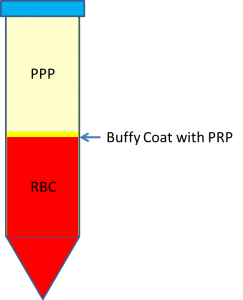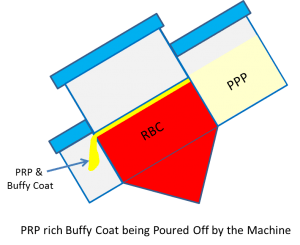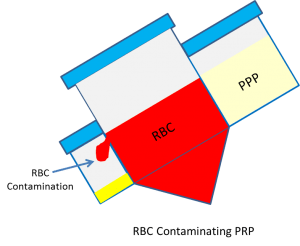Dirty little PRP Machine…
This past few months, we’ve had many physicians in our offices learning advanced regenerative medicine techniques and the orthopedics 2.0 approach. One trend I’ve noticed is that many of these physicians ask us how we deal with our post-PRP injection flare-ups. This has caught us by surprise, as when we use the Regenexx-SCP procedure (blood platelets plus blood stem cells), we generally don’t see any flare-ups. Several of the doctors have also brought up that our Regenexx-SCP procedure produces an amber liquid while they’re used to getting a reddish tinted PRP from their bedside machines. When I heard this I immediately knew why their patients were flaring up with PRP and our patients had less flare-ups-it’s all about the blood. Introducing blood into a joint fools the joint into believing a serious trauma has occurred, as the only reason blood would suddenly appear in a joint naturally would be due to serious injury. This blood then leads to a severe inflammatory reaction in the joint. Some of these severe swelling episodes described by our visiting physicians have lead to scaring in the joint (for example a frozen shoulder). Our Regenexx-SCP procedures processes blood in a way where the platelets are concentrated and the stem cells are preserved, but without the high concentrations of blood contamination commonly seen in commercially available bedside PRP machines. Why? Our -SCP procedure is done by hand, so the experienced technician can perform the procedure to reduce blood contamination. However, a PRP machine is a sloppy affair. Let me explain why.

Above is a three chambered device that the doctor places in a specially designed centrifuge. In this example, the doctor places the whole blood into the middle chamber and the centrifuge first spins the blood to separate the layers. After this first spin, a second spin tilts the whole plastic apparatus to one side and a small opening spills the PPP into one chamber (shown above). As you might imagine, this is a computer controlled routine without any way for the computer to accurately see how much of the PPP is spilling over, so many times some of the platelets in the middle buffy coat spill into the PPP waste bucket. The best the machine can do is to play the law of averages, considering only what happens when you run the average patient’s sample. The actual blood sample being placed into the machine might be more or less viscous, have more or less volume, or have more or less platelets or red cells than this average. All of these important patient to patient differences impact the efficiency of the process. In essence, compared to an experienced lab technician, the machine is very sloppy because it can’t adjust the processing to fit the sample.



If you have questions or comments about this blog post, please email us at [email protected]
NOTE: This blog post provides general information to help the reader better understand regenerative medicine, musculoskeletal health, and related subjects. All content provided in this blog, website, or any linked materials, including text, graphics, images, patient profiles, outcomes, and information, are not intended and should not be considered or used as a substitute for medical advice, diagnosis, or treatment. Please always consult with a professional and certified healthcare provider to discuss if a treatment is right for you.

